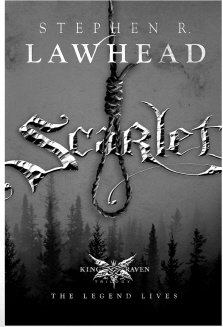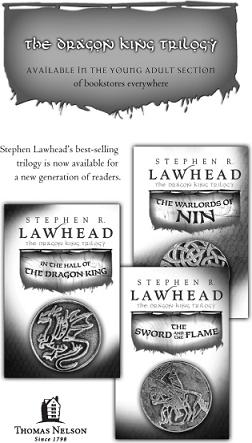Hood (52 page)

In the earliest stories, Robin was no honourable Errol Flynn-esque hero. He was a coarse and vulgar oaf much given to crudeness and violence. He was a thief from the beginning, to be sure, but the now-famous creed of “robbing from the rich to give to the poor” was a few hundred years removed from his rough highwayman origins. The early Robin robbed from the rich, to be sure—and kept every silver English penny for himself.
As time went on, the threadbare tales acquired new and better clothes—until they possessed a whole wardrobe full of rich, colourful, sumptuous medieval regalia in the form of characters, places, incidents, and adventures. Characters such as Little John, Friar Tuck, Will Scarlet, and Sir Guy of Gisbourne joined the ranks one by one in various times and places as different composers and writers spun out the old tales and made up new ones. The Sheriff of Nottingham was an early addition and, contrary to popular opinion, was not always the villain of the piece. The beautiful, plucky Maid Marian was actually one of the last characters to arrive on the scene, making her debut sometime around the beginning of the sixteenth century.
Others are notable by their absence. In the early tales there is no evil King John and no good King Richard—no king at all. And the only monarch who receives so much as a mention is “Edward, our comely king,” though which of the many Edwards this might be is never made clear.
So we have an amorphous body of popular songs and poems about a lovable rascal whose name was uncertain and who lived someplace on the island of Britain at some unknown time in the past. Of all the possibilities to choose from in locating the legend in place and time, why choose Wales?
Several small but telling clues serve to locate the original source of the legend in the area of Britain now called Wales in the generation following the Norman invasion and conquest of 1066. First and foremost is the general character of the people themselves, the Welsh (from the Saxon
wealas
, or “foreigners”), or as they would have thought of themselves, the Britons.
In AD 1100, Gerald of Wales, a highborn nobleman whose mother was a Welsh princess, wrote of his people: “The Welsh are extreme in all they do, so that if you never meet anyone worse than a bad Welshman, you will never meet anyone better than a good one.” He went on to describe them as extremely hardy, extremely generous, and extremely witty. They were also, he cautioned, extremely treacherous, extremely vengeful, and extremely greedy for land. “Above all,” he writes, “they are passionately devoted to liberty, and almost excessively warlike.”
Gerald painted a picture of the Cymry as a whole nation of warriors in arms. Unlike the Normans, who were sharply divided between the military aristocracy and a mass of peasants, every single Welshman was ready for battle at a moment’s notice; women, too, bore arms and knew how to use them.
Within two months of the Battle of Hastings (1066), William the Conqueror and his barons, the new Norman overlords, had subdued 80 percent of England. Within two years, they had it all under their rule. However—and I think this is significant—it took them over two
hundred
years of almost continual conflict to make any lasting impression on Wales, and by that late date it becomes a question of whether Wales was really ever conquered at all.
In fact,William the Conqueror, recognising an implacable foe and unwilling to spend the rest of his life bogged down in a war he could never win, wisely left the Welsh alone. He established a baronial buffer zone between England and the warlike Britons. This was the territory known as the March. Later, this sensible no-go area and its policy of tolerance would be violated by the Conqueror’s brutish son,William II, who sought to fill his tax coffers to pay for his spendthrift ways and expensive wars in France. Wales and its great swathes of undeveloped territory seemed a plum ripe for the plucking, and it is in this historical context (in the year AD 1093) that I have chosen to set
Hood
.
A Welsh location is also suggested by the nature and landscape of the region. Wales of the March borderland was primeval forest. While the forests of England had long since become well-managed business property where each woodland was a veritable factory, Wales still had enormous stretches of virgin wood, untouched except for hunting and hiding. The forest of the March was a fearsome wilderness when the woods of England resembled well-kept garden preserves. It would have been exceedingly difficult for Robin and his outlaw band to actually hide in England’s ever-dwindling Sherwood, but he could have lived for years in the forests of the March and never been seen or heard.
This entry from the Welsh chronicle of the times known as
Brenhinedd Y Saesson
, or
The Kings of the Saxons,
makes the situation very clear:
Anno Domini MLXXXXV (1095). In that year King William Rufus mustered a host past number against the Cymry. But the Cymry trusted in God with their prayers and fastings and alms and penances and placed their hope in God.
And they
harassed their foes so that the Ffreinc dared not go into the woods
or the wild places, but they traversed the open lands sorely fatigued,
and thence returned home empty-handed. And thus the Cymry
boldly defended their land with joy
. (emphasis mine)
That, I think, is the Robin Hood legend in seed form. The plucky Britons, disadvantaged in the open field, took to the forest and from there conducted a guerrilla war, striking the Normans at will from the relative safety of the woods—an ongoing tactic that would endure with considerable success for whole generations. That is the kernel from which the great durable oak of legend eventually grew.
Finally, we have the Briton expertise with the warbow, or longbow as it is most often called. While one can read reams of accounts about the English talent for archery, it is seldom recognized—but well documented—that the Angles and Saxons actually learned the weapon and its use from the Welsh. No doubt, the invaders learned fear and respect for the longbow the hard way before acquiring its remarkable potential for themselves.
As military historian Robert Hardy has observed, “The Welsh were the first people on the British Isles to have and use longbows. The Welsh became experts in the use of the longbow, and used the longbow very effectively in battles against the invading English.” The Welsh repelled Ralph, Earl of Hereford, in 1055 using the longbow. There is a story about Welsh longbowmen penetrating a four-inch-thick, solid oak door with their arrows at the siege of Abergavenny Castle. Hardy goes on to say,
Like the Welsh, the English learned an important lesson by fighting against the longbow. That lesson being that the longbow is a formidable weapon when used correctly.With the eventual defeat of the Welsh, and “alliance” of the English and Welsh, the English employed Welsh longbowmen in its own army. During this time, the English began a campaign to train their own longbowmen as well.
In his book
Famous Welsh Battles
, British historian Philip Warner writes:
There were no easy victories over the Welsh. They were greatly esteemed and widely feared, whether fighting as mercenaries in the Middle Ages or engaging in guerrilla combat. From south Wales came a new weapon, the longbow, as terrifying as modern weapons of mass murder. Some 6 feet long and discharging an arrow 3 feet in length, averaging 12 arrows a minute, they blanketed a target like a dark, vengeful cloud. In the next moment all would be groans, screams and confusion.
Taken altogether, then, these clues of time, place, and weaponry indicate the germinal soil out of which Robin Hood sprang. As for the English Robin Hood with whom we are all so familiar . . . just as Arthur, a Briton, was later Anglicised—made into the quintessential English king and hero by the same enemy Saxons he fought against—a similar makeover must have happened to Robin. The British resistance leader, outlawed to the primeval forests of the March, eventually emerged in the popular imagination as an aristocratic Englishman, fighting to right the wrongs of England and curb the powers of an overbearing monarchy. It is a tale that has worn well throughout the years. However, the real story, I think, must be far more interesting.
And so, in an attempt to centre the tales of this British hero in the time and place where I think they originated—
not
where they eventually ended up—I have put a British Rhi Bran, and all his merry band of friends and enemies, in Wales.
—Stephen Lawhead
The author gratefully acknowledges the assistance of Mieczys aw Piotrowski and the cooperation of Józef Popiel, Director of Biaowieski National Park, Poland, who kindly allowed me to roam freely in the last primeval forest in Europe.
Many of the old Celtic words and names are strange to modern eyes, but they are not as difficult to pronounce as they might seem at first glance. A little effort—and the following rough guide—will help you enjoy the sound of these ancient words.
Consonants
– As in English, but with the following exceptions:
| c: | hard, as in cat (never soft, as in cent) |
| ch: | hard, as in Bach (never soft, as in church) |
| dd: | a hard th sound, as in then |
| f: | a hard v sound, as in of |
| ff: | a soft f sound, as in off |
| g: | hard, as in girl (never soft, as in George) |
| ll: | a Gaelic distinctive, sounded as tl or hl on the sides of the tongue |
| r: | rolled or slightly trilled, especially at the beginning of a word |
| rh: | breathed out as if h-r and heavy on the h sound |
| s: | soft, as in sin (never hard, as in his); when followed by a vowel it takes on the sh sound |
| th: | soft, as in thistle (never hard, as in then) |
Vowels
– As in English, but generally with the lightness of short vowel sounds
| a: | short, as in can |
| á: | slightly softer than above, as in awe |
| e: | usually short, as in met |
| é: | long a sound, as in hey |
| i: | usually short, as in pin |
| í: | long e sound, as in see |
| o: | usually short, as in hot |
| ó: | long o sound, as in woe |
| ô: | long o sound, as in go |
| u: | usually sounded as a short i, as in pin |
| ú: | long u sound, as in sue |
| ù: | short u sound, as in muck |
| w: | sounded as a long u, as in hue; before vowels often becomes a soft consonant as in the name Gwen |
| y: | usually short, as in pin; sometimes u as in pun; when long, sounded e as in see; rarely, y as in why |
The careful reader will have noted that there is very little difference between
i
,
u
, and
y
—they are almost identical to non-Celts and modern readers.
Most Celtic words are stressed on the next to the last syllable. For example, the personal name Gofannon is stressed go-FAN-non, and the place name Penderwydd is stressed pen-DER-width, and so on.

AVAILABLE EVERYWHERE
Book Two in the King Raven Trilogy

A
s the story of King Raven continues, the stakes grow ever higher and the lives of Bran’s band hang ever more in the balance. Will Scarlet is about to be hung. Bran discovers a secret that leads them on a desperate sea voyage to France in a daring attempt to reveal the plot against King William by his brother, Duke Robert, and the greedy Baron de Braose.
Will Bran’s loyalty regain him the throne of Elfael? Or will his efforts only increase the sheriff ’s determination to destroy King Raven?

